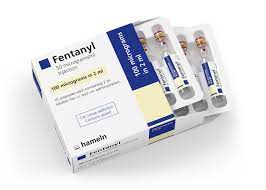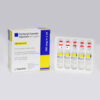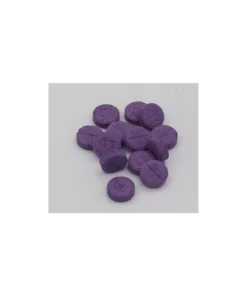$150.00 Original price was: $150.00.$125.00Current price is: $125.00.
Fentanyl is a strong opioid painkiller. It’s used to treat severe pain, for example during or after an operation or a serious injury, or pain from cancer. It is also used for other types of pain that you’ve had for a long time when weaker painkillers have stopped working.
Fentanyl is a strong opioid painkiller. It’s used to treat severe pain, for example during or after an operation or a serious injury, or pain from cancer.
It is also used for other types of pain that you’ve had for a long time when weaker painkillers have stopped working.
Fentanyl is available only on prescription. It comes as:
- patches to be put on your skin
- lozenges and tablets that dissolve in the mouth
- nasal spray
- injections (usually only given in hospital)
Fentanyl patches are used for long-lasting pain. Your doctor may also prescribe other types of fentanyl if you need extra pain relief while your regular painkiller wears off.
2. Key facts
- The most common side effects of fentanyl are constipation, and feeling sick and sleepy.
- It is possible to become addicted to fentanyl, but your doctor will explain how to reduce the risks of becoming addicted.
- If you need to take fentanyl for more than a few weeks, your treatment plan may include details of how and when to stop taking this medicine.
- It’s best not to drink alcohol when you first start taking (or using) fentanyl. You’re more likely to get side effects such as feeling sleepy or drowsy.
- Tell a doctor or nurse about your fentanyl patch if you’re having any treatment or tests. Also, remind your pharmacist about your patch when you collect prescriptions or buy other medicines.
3. Who can and cannot take fentanyl
Fentanyl can be used by most adults.
Some patches can be used in children from the age of 2 years and over. However, young children and older people are more likely to get side effects.
Fentanyl patches are usually only used if you’ve already been taking other strong opioid painkillers. Your doctor will work out how much fentanyl to give you depending on what dose of other opioids you have been taking. This is to reduce the risk of an overdose.
Fentanyl is not suitable for some people. Tell your doctor before starting this medicine if you:
- have ever had an allergic reaction to fentanyl or any other medicines
- have breathing difficulties such as asthma or a lung condition
- are addicted to alcohol or a heavy drinker
- have a head injury or condition that causes fits or seizures
- have irregular heartbeats (arrhythmia)
- have adrenal gland problems
- have kidney or liver problems
- have an enlarged prostate
- have low blood pressure
- are trying to get pregnant, are pregnant or breastfeeding
4. How and when to take it
Follow your doctor’s instructions about how to use this medicine. This is particularly important because fentanyl can be addictive.
Doses vary from person to person. Your dose will depend on how bad your pain is, how you’ve responded to other painkillers and if you get any side effects from fentanyl.
Fentanyl tablets, lozenges, nasal spray and injections are fast-acting. They’re used for pain that is expected to last for a short time.
Fentanyl patches are slow-release. This means fentanyl is gradually released through the skin into your body.
How often to take or use fentanyl
How often you take or use fentanyl depends on the type that you’ve been prescribed:
- patches – apply a new patch every 3 days (remove the old one first)
- tablets, lozenges and nasal spray – usually only when you need them
Some patches keep working after they’ve been removed as they “store” fentanyl under the skin. Fentanyl patches take longer to start working but last longer. They’re used for when pain lasts for a long time.
Sometimes your doctor may prescribe a fentanyl patch with a fast-acting painkiller. This is to manage sudden flare-ups of pain that “break through” the relief the patches give.
Important:Overdose warning
Do not apply more than 1 patch at a time, unless your doctor tells you to.
Using more patches than recommended could lead to a fatal overdose.
Strength of fentanyl
The different types of fentanyl come in a range of strengths:
- patches – these release 12 micrograms to 100 micrograms of fentanyl every hour
- nasal spray – 50 micrograms to 400 micrograms
- tablets – 100 micrograms to 800 micrograms
- lozenges – 200 micrograms to 1,600 micrograms
Will my dose go up or down?
Before taking or using fentanyl, you will usually start on a low dose of another type of opioid, such as morphine. This will be increased slowly until your pain is well controlled.
Once your pain is under control, your doctor may swap you to fentanyl patches. This will avoid you having to take tablets or capsules each day.
If your doctor agrees that you can stop taking fentanyl, they will reduce the strength of your patch gradually. This is especially important if you’ve been taking it for a long time to reduce the risk of withdrawal symptoms.
Your doctor may switch you to morphine tablets or liquid or another similar painkiller so that they can reduce the dose of fentanyl even more slowly.
How to apply a fentanyl patch
- Read the instructions that come with your patch carefully.
- Remove the patch from the packet – do not use scissors to open it as you may cut the patch. Do not cut patches unless your doctor has told you to.
- Keep the empty packet – you will need to put your used patch in this to keep it safe. You will then need to return it to your pharmacist who will destroy it in the right way.
- Peel off the plastic from the back of the patch. Do not touch the sticky side of the patch.
- Apply the patch to clean, dry, flat, undamaged skin. Do not touch the sticky side of the patch. Choose somewhere you can reach easily such as the top of your chest or top of your arm. Try to avoid very hairy areas, or clip the hairs first before applying the patch. If you find shaving easier, shave the area a few days before you apply the patch to make sure shaving does not irritate your skin.
- If your doctor tells you to use more than 1 patch, follow the instructions that come with the patches. Do not let the patches overlap on your skin.
- Do not cover the patch or patches with anything, including a dressing or tape. Talk to your doctor or pharmacist if you find your patch does not stick very well.
- Wash your hands after touching a patch.
Do not expose your patch to strong heat or sunlight. This can increase the amount of fentanyl that gets absorbed into your skin and can increase the risk of side effects or overdose. This includes long hot baths, saunas, electric blankets, hot water bottles, heat pads and sunbathing.
You can have showers and go swimming. Check the patch is still on properly afterwards and dry the area around the patch carefully.
What to do if your patch falls off
Check your patch every day to make sure it stays stuck to you, especially around the edges.
Be the first to review “FENTANYL 100MG” Cancel reply
Related products
Psychedelics
Psychedelics
Psychedelics
Psychedelics
Psychedelics
Psychedelics


















Reviews
There are no reviews yet.